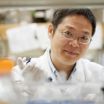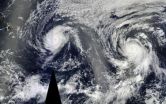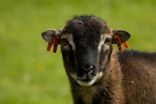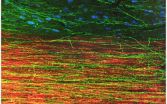(Press-News.org) For years, a team of researchers at MIT and Harvard University has been working on origami robots — reconfigurable robots that would be able to fold themselves into arbitrary shapes.
In the August 7 issue of Science, they report their latest milestone: a robot, made almost entirely from parts produced by a laser cutter, that folds itself up and crawls away as soon as batteries are attached to it.
"The exciting thing here is that you create this device that has computation embedded in the flat, printed version," says Daniela Rus, the Andrew and Erna Viterbi Professor of Electrical Engineering and Computer Science at MIT and one of the Science paper's co-authors. "And when these devices lift up from the ground into the third dimension, they do it in a thoughtful way."
Rus is joined on the paper by Erik Demaine, an MIT professor of computer science and engineering, and by three researchers at Harvard's Wyss Institute for Biologically Inspired Engineering and School of Engineering and Applied Sciences: Sam Felton, Michael Tolley, and Rob Wood.
At the IEEE International Conference on Robotics and Automation this spring, Rus, Demaine, Wood, and five other researchers at MIT and Harvard presented a paper on bakable robots, which would self-assemble from laser-cut materials when uniformly heated. The new work is similar, but a network of electrical leads, rather than an oven or hot plate, delivers heat to the robot's joints to initiate folding.
"That's exciting from a geometry standpoint," Demaine says, "because it lets us fold more things. Because we can do the sequencing, we have a lot more control. And it lets us make active folding structures. Instead of just self-assembly, you can then make it walk."
The robot is built from five layers of materials, all cut according to digital specifications by a laser cutter. The middle layer is copper, etched into an intricate network of electrical leads. It's sandwiched between two structural layers of paper; the outer layers are composed of a shape-memory polymer that folds when heated.
After the laser-cut materials are layered together, a microprocessor and one or more small motors are attached to the top surface. In the prototype, that attachment was done manually, but it could instead be performed by a robotic "pick and place" system.
"There is a magic sauce in the mechanical design that forms the leg system that can be actuated with one motor," Rus says.
In fact, while the researchers experimented with both single-motor and four-motor designs, the Science paper reports a design that uses two motors. Each motor controls two of the robot's legs; the motors are synchronized by the microprocessor. Each leg, in turn, has eight mechanical "linkages," and the dynamics of the linkages convert the force exerted by the motor into movement.
"It's called a one-degree-of-freedom structure, in which you just need to turn one crank and the whole thing moves in the way that you want," Demaine explains. "It lets you transfer just one degree of freedom into a whole complicated motion, all through the mechanics of the structure."
In prior work, Rus, Demaine, and Wood developed an algorithm that could automatically convert any digitally specified 3-D shape into an origami folding pattern. The design of the new robot was intended to demonstrate not only the possibility of motion generation, but also the ability to perform the two folds necessary to produce arbitrary shapes. "You need to be able to do a single fold, ideally all the way to 180 degrees, in both directions," Demaine says. "Then the next level of challenge is to do what's called a cyclic fold, where you have a bunch of panels connected together in a cycle, and they can all fold simultaneously. That's demonstrated in one component of the system."
The sharpest fold that the prototype system can execute is 150 degrees, not 180. But as Demaine explains, in origami, 180-degree folds are generally used to join panels together. With 150-degree folds, the panels won't quite touch, but that's probably tolerable for many applications.
In the meantime, Demaine is planning to revisit the theoretical analysis that was the basis of the researchers' original folding algorithm, to determine whether it's still possible to produce arbitrary three-dimensional shapes with folds no sharper than 150 degrees.
"It's very exciting because there is always work to be done between theory and devices," Rus says. "I make robots and love theory, and Erik proves theorems and loves mechanisms. In order for this research to work, you need people who are of the same mind about what is important."
INFORMATION:
The work was funded by the National Science Foundation, the Wyss Institute for Biologically Inspired Research at Harvard, and the Air Force Office of Scientific Research.
Written by Larry Hardesty, MIT News Office
Related links
Bake your own robot:
http://newsoffice.mit.edu/2014/bake-your-own-robot-0530
Shape-shifting robots:
http://newsoffice.mit.edu/2010/programmable-matter-0805
Origami robot folds itself up, crawls away
Prototype made almost entirely of printable parts demonstrates crucial capabilities of reconfigurable robots
2014-08-07
ELSE PRESS RELEASES FROM THIS DATE:
NASA sees heavy rainfall in Iselle as the hurricane nears Hawaii
2014-08-07
VIDEO:
TRMM satellite rainfall data overlaid on an enhanced infrared image from NOAA's GOES-West satellite shows heavy rainfall occurring around the Iselle's eye. The most intense rain was falling at a...
Click here for more information.
A NASA satellite has observed heavy rainfall in Hurricane Iselle on its approach to Hawaii. NASA's TRMM Satellite captured rainfall rates within the storm as it passed overhead. In addition, NASA's Aqua satellite provided a larger view of the Central ...
Cell signaling pathway linked to obesity, type 2 diabetes
2014-08-07
WEST LAFAYETTE, Ind. - A Purdue University study shows that Notch signaling, a key biological pathway tied to development and cell communication, also plays an important role in the onset of obesity and Type 2 diabetes, a discovery that offers new targets for treatment.
A research team led by Shihuan Kuang, associate professor of animal sciences, found that blocking Notch signaling in the fat tissue of mice caused white fat cells to transform into a "leaner" type of fat known as beige fat. The finding suggests that suppressing Notch signaling in fat cells could reduce ...
Gut microbes browse along a gene buffet
2014-08-07
DURHAM, N.C. -- In the moist, dark microbial rainforest of the intestine, hundreds of species of microorganisms interact with each other and with the cells of the host animal to get the resources they need to survive and thrive.
Though there's a lot of competition in this vibrant ecosystem, collaboration is valued too. A new study on the crosstalk between microbes and cells lining the gut of mice shows just how cooperative this environment can be.
One of the main ways that hosts manage their interactions with microbes is by carefully controlling the genes that their ...
NASA sees Hurricane Julio organize and emit a gamma-ray flash
2014-08-07
NASA's Fermi and Aqua satellites captured two different views of bursts of strength show by Hurricane Julio as it intensified. NASA's Fermi satellite saw a gamma-ray flash from Julio, while NASA's Aqua satellite saw Julio become more structurally organized as a hurricane.
This type of outburst is known as a terrestrial gamma-ray flash (TGF). Produced by the powerful electric fields in thunderstorms, TGFs last only a few thousandths of a second but emit gamma rays that make up the highest-energy naturally-occurring light on Earth. Scientists estimate that, on average, ...
Wild sheep show benefits of putting up with parasites
2014-08-07
In the first evidence that natural selection favors an individual's infection tolerance, researchers from Princeton University and the University of Edinburgh have found that an animal's ability to endure an internal parasite strongly influences its reproductive success. Reported in the journal PLoS Biology, the finding could provide the groundwork for boosting the resilience of humans and livestock to infection.
The researchers used 25 years of data on a population of wild sheep living on an island in northwest Scotland to assess the evolutionary importance of infection ...
NASA sees Genevieve cross international date line as a Super-Typhoon
2014-08-07
Tropical Storm Genevieve had ups and downs in the Eastern Pacific and Central Pacific over the last week but once the storm crossed the International Dateline in the Pacific, it rapidly intensified into a Super Typhoon. NASA-NOAA's Suomi NPP satellite captured of the storm.
When Suomi NPP flew over Genevieve on August 7 at 01:48 UTC the Visible Infrared Imaging Radiometer Suite (VIIRS) instrument aboard captured an infrared image of the storm. VIIRS collects visible and infrared imagery and global observations of land, atmosphere, cryosphere and oceans. VIIRS flies aboard ...
Dramatic growth of grafted stem cells in rat spinal cord injuries
2014-08-07
Building upon previous research, scientists at the University of California, San Diego School of Medicine and Veteran's Affairs San Diego Healthcare System report that neurons derived from human induced pluripotent stem cells (iPSC) and grafted into rats after a spinal cord injury produced cells with tens of thousands of axons extending virtually the entire length of the animals' central nervous system.
Writing in the August 7 early online edition of Neuron, lead scientist Paul Lu, PhD, of the UC San Diego Department of Neurosciences and colleagues said the human iPSC-derived ...
Human skin cells reprogrammed as neurons regrow in rats with spinal cord injuries
2014-08-07
While neurons normally fail to regenerate after spinal cord injuries, neurons formed from human induced pluripotent stem cells (iPSCs) that were grafted into rats with such injuries displayed remarkable growth throughout the length of the animals' central nervous system. What's more, the iPSCs were derived from skin cells taken from an 86-year-old man. The results, described in the Cell Press journal Neuron, could open up new possibilities in stimulating neuron growth in humans with spinal cord injuries
"These findings indicate that intrinsic neuronal mechanisms readily ...
Cancer study reveals powerful new system for classifying tumors
2014-08-07
Cancers are classified primarily on the basis of where in the body the disease originates, as in lung cancer or breast cancer. According to a new study, however, one in ten cancer patients would be classified differently using a new classification system based on molecular subtypes instead of the current tissue-of-origin system. This reclassification could lead to different therapeutic options for those patients, scientists reported in a paper published August 7 in Cell.
"It's only ten percent that were classified differently, but it matters a lot if you're one of those ...
Largest cancer genomic study proposes 'disruptive' new system to reclassify tumors
2014-08-07
Novato, California: Researchers with The Cancer Genome Atlas (TCGA) have analyzed more than 3500 tumors on multiple genomic technology platforms, revealing a new approach to classifying cancers. This largest-of-its-kind study, published online August 7th in Cell featured major contributions by Buck faculty Christopher Benz, MD and Senior Staff Scientist Christina Yau, PhD.
TCGA scientists analyzed the DNA, RNA and protein from 12 different tumor types using six different TCGA "platform technologies" to see how the different tumor types compare to each other. The study ...
LAST 30 PRESS RELEASES:
Making lighter work of calculating fluid and heat flow
Normalizing blood sugar can halve heart attack risk
Lowering blood sugar cuts heart attack risk in people with prediabetes
Study links genetic variants to risk of blinding eye disease in premature infants
Non-opioid ‘pain sponge’ therapy halts cartilage degeneration and relieves chronic pain
AI can pick up cultural values by mimicking how kids learn
China’s ecological redlines offer fast track to 30 x 30 global conservation goal
Invisible indoor threats: emerging household contaminants and their growing risks to human health
Adding antibody treatment to chemo boosts outcomes for children with rare cancer
Germline pathogenic variants among women without a history of breast cancer
Tanning beds triple melanoma risk, potentially causing broad DNA damage
Unique bond identified as key to viral infection speed
Indoor tanning makes youthful skin much older on a genetic level
Mouse model sheds new light on the causes and potential solutions to human GI problems linked to muscular dystrophy
The Journal of Nuclear Medicine ahead-of-print tip sheet: December 12, 2025
Smarter tools for peering into the microscopic world
Applications open for funding to conduct research in the Kinsey Institute archives
Global measure underestimates the severity of food insecurity
Child survivors of critical illness are missing out on timely follow up care
Risk-based vs annual breast cancer screening / the WISDOM randomized clinical trial
University of Toronto launches Electric Vehicle Innovation Ontario to accelerate advanced EV technologies and build Canada’s innovation advantage
Early relapse predicts poor outcomes in aggressive blood cancer
American College of Lifestyle Medicine applauds two CMS models aligned with lifestyle medicine practice and reimbursement
Clinical trial finds cannabis use not a barrier to quitting nicotine vaping
Supplemental nutrition assistance program policies and food insecurity
Switching immune cells to “night mode” could limit damage after a heart attack, study suggests
URI-based Global RIghts Project report spotlights continued troubling trends in worldwide inhumane treatment
Neutrophils are less aggressive at night, explaining why nighttime heart attacks cause less damage than daytime events
Menopausal hormone therapy may not pose breast cancer risk for women with BRCA mutations
Mobile health tool may improve quality of life for adolescent and young adult breast cancer survivors
[Press-News.org] Origami robot folds itself up, crawls awayPrototype made almost entirely of printable parts demonstrates crucial capabilities of reconfigurable robots





